Methods of Reducing the Front Performance Flame at the Underground Mines Works
M. I. Tulepov1,2, Z. A. Mansurov1,2, Yu. V. Kazakov1,2, F. Yu. Abdrakova1,2, Z. L. Sultanova1, N. M. Rakhova1,2, S. S. Madiyev 1, O. Yu. Golovchenko1,2, L. R. Sassykova1,2 , D. M. Tolep1, N. Chikhradze3 and M. N. Chikhradze3
, D. M. Tolep1, N. Chikhradze3 and M. N. Chikhradze3
1Al-Farabi Kazakh National University, 71, al-Farabi ave., 050040, Almaty, Kazakhstan.
2The Combustion Problems Institute, 172, Bogenbaibatyr str., 050012, Almaty, Kazakhstan.
3LEPL G. Tsulukidze Mining Institute, Tbilisi, 0186, Georgia.
Corresponding Author E-mail: larissa.rav@mail.ru
DOI : http://dx.doi.org/10.13005/ojc/340645
Article Received on : 04-11-2018
Article Accepted on : 11-12-2018
Article Published : 11 Dec 2018
The aim of the study was to develop methods to reduce the penetration ability of the flame front and red-hot striking elements that propagate in the confined space of mines. In the article is considered a method for localizing explosions of a methane-dust mixture in coal mines, by creating an aqueous barrier (increased density) in the propagation path of the flame front and incandescent particles, using a high-energy pyrotechnic composition based on nanoaluminum. The optimal pyrotechnic composition contents of ammonium nitrate - 50%, smokeless powder - 45%, magnesium - 3% and nanoaluminum - 2%. This composition punched the target to a depth of 6.5 mm with a barrier thickness of 50 mm. Water cannon with a nozzle with a diameter of 80mm, allows to localize the spread of the flame front.
KEYWORDS:Magnesium; Nanoaluminum; Pyrotechnic Composition; Smokeless Powder
Download this article as:| Copy the following to cite this article: Tulepov M. I, Mansurov Z. A, Kazakov Y. V, Abdrakova F. Y, Sultanova Z. L, Rakhova N. M, Madiyev S. S, Golovchenko O. Y, Sassykova L. R, Tolep D. M, Chikhradze N, Chikhradze M. N. Methods of Reducing the Front Performance Flame at the Underground Mines Works. Orient J Chem 2018;34(6). |
| Copy the following to cite this URL: Tulepov M. I, Mansurov Z. A, Kazakov Y. V, Abdrakova F. Y, Sultanova Z. L, Rakhova N. M, Madiyev S. S, Golovchenko O. Y, Sassykova L. R, Tolep D. M, Chikhradze N, Chikhradze M. N. Methods of Reducing the Front Performance Flame at the Underground Mines Works. Orient J Chem 2018;34(6). Available from: http://www.orientjchem.org/?p=53713 |
Introduction
In the process of mining in a closed mining method, the probability of accumulation of methane-dust mist is high. Often, this leads to accidents involving catastrophic gas and dust explosions. Such explosions of gas and coal dust are accidents with the most serious consequences in social and economic terms.1-6 Such explosions are often accompanied by group accidents, in some cases claiming hundreds of human lives.7-12
Localization and prevention of explosions in coal mines is a complex organizational and technical challenge. Methods of localizing the explosion of dust-gas-air mixtures in workings are the subject of scientific research.13-21
The purpose of this study is to develop methods to reduce the penetration ability of the flame front and red-hot striking elements that propagate in the confined space of mines.
Materials and Methods
During testing, formulations were prepared with a different ratio of components. The following components were used: granulated ammonium nitrate (AN), smokeless powder, magnesium powder, nanoaluminum.
The compositions are thoroughly mixed and introduced into a waterproof cartridge. Initiation was carried out with the help of electricity through the nichrome thread.
Studies have been carried out on the penetrating ability of the veil, which in the first case consists of water and in the second case from a saturated solution of common salt.
Table 1: The initial compositions for testing.
| Noof a composition | The content of components in the composition, % | |||
| AN | Smokeless powder | Mg | Nanoaluminum | |
| 1 | 50.0 | 45.0 | 3.0 | 2.0 |
| 2 | 50.0 | 45.0 | 2.0 | 3.0 |
| 3 | 50.0 | 40.0 | 6.0 | 4.0 |
| 4 | 45.0 | 50.0 | 3.0 | 2.0 |
| 5 | 45.0 | 50.0 | 2.0 | 3.0 |
| 6 | 40.0 | 50.0 | 6.0 | 4.0 |
The fire experimental installation for studies the conditions for burning a sample of the fine fraction AN with the addition of nanoaluminum, is made on the basis of a modernized high-temperature electric arc pipe equipped with a thermostat.22 The thermostat automatically maintains the required temperature of the gas medium in its working volume. Heat losses through the setting of the combustion chamber are replenished by the load circuit of the installation (heating elements). Thanks to this design, heat losses by the convective transfer in the system are replenished and, accordingly, are not taken into account. Heat transfer is modeled by the interaction of the reacting mixture with an irradiator, the temperature of which is dependent on time. The heat exchange between the particle and the gaseous medium occurs by convection and diffusion thermal conductivity.
The technique of sample preparation was as follows:
Weighing → Dry mixing of oxidant and fuel manually → Mixing with a binder → Pressing in a hydraulic mold → Drying → Test → Fixing the release of volatile substances.23-27
Results and Discussion
By carefully mixing the magnesium powder with smokeless powder and nanoaluminum, a fine distribution of one component on the surface of the other component can be obtained. Fig.1 shows a micrograph of a mixture of Mg + AN + Al. According to the results of studies of the surface morphology of the mixture obtained using SEM, it was found that after mixing the components of Mg and Al is on the surface of the AN in the form of spraying.
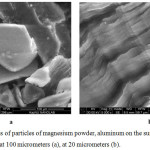 |
Figure 1: SEM images of particles of magnesium powder, aluminum on the surface of ammonium nitrate in resolutions at 100 micrometers (a), at 20 micrometers (b). |
Researches of processes of burning and detonation and also test for efficiency of the synthesized compositions on protection by the water screen and efficiency of the filter with table salt were carried out.
The mathematical model described by a system of the following differential equations corresponds to the adopted chemical mechanism of combustion and assumptions:
1 Equation of the kinetics of release (r) of volatile substances.
dVr/dτ=(Vw – Vdamp)αwet (1.1)
where Vw is the content of “wet” volatile substances in the fuel;
αwet is the rate constant for the release of volatile substances;
Vdamp is a number of “damp” volatile substances leaving the fuel, kg / kg.
The constant of the rate of release of volatile substances in this case is determined by the dependence:

where R0vr is a kinetic constant of volatiles release, vr is volatile substances release.
Exit and burning of volatile substances is a kinetic process. When burning fuel with aluminum nano-additives, there is a decrease in the activation energy of the primary combustion reactions of pyrophoric compounds by an amount characterizing the energy difference between the ground and singlet oxygen states ΔΕ = 94.2 · 103 kJ / kmol. In the mathematical model, this feature is taken into account by the introduction of the coefficients of the intensification of reactions:
k1= ΔΕ / E1, k1 = ΔΕ / E2, (For AC k1RC =0.33, k1RC = 0.3) (1.3)
We assume that all the generated oxygen is consumed for the primary reactions, therefore, its participation in the secondary combustion of carbon monoxide is minimal, which is taken into account by a factor close to unity k12 = 1.1.
The first stage of experiments was preparation (tab.1) and testing pyrotechnic compositions (PС), tab.2. At the initial moment of PC testing the temperature of the gaseous medium in the reactor significantly exceeds the temperature of the pyrotechnic composition. Particle PC – Mg/Nanoaluminum perceives the heat of the gaseous medium by convection and radiation from the irradiator. The release and combustion of volatile substances and Mg/nanoaluminum occured simultaneously with the transition to detonation. The heat of chemical reaction occurring on the surface of the PC is transferred by convection and diffusive thermal conductivity of the surrounding gaseous medium, by radiation to the irradiator and is partially spent on heating the PC itself.
The data in tab.2 show that all 6 compositions detonated flawlessly. In terms of their physico-chemical characteristics, these compositions differ slightly. Compounds with a high percentage of aluminum showed better penetrability. According to the results of the experiments, the optimal composition of pyrotechnic composition No. 1 was selected (see tab.1).
Table 2: Depth of damage through a water barrier.
| No | AN/ smokeless powder, wt. % | Mg/nanoaluminium, wt. % | Detonation | Depth of damage through a water barrier 50 mm thick, mm |
| 1 | 50/45 | 3/2 | + | 6.2 |
| 2 | 50/45 | 2/3 | + | 6.5 |
| 3 | 50/40 | 6/4 | + | 6.6 |
| 4 | 45/50 | 3/2 | + | 5.5 |
| 5 | 45/50 | 2/3 | + | 6.0 |
| 6 | 40/50 | 6/4 | + | 6.5 |
The release of combustible volatile substances continues and ends in the process of burning PC. At the interim moment of the combustion process, the PC particle consists of ash and not evolved part of volatile gases. Therefore, the density of the burning particle PC at an intermediate point in time is determined by the expression:
ρp = ρs + ρcm (Vwv – Vwvl) kg/m3 (1.4)
Assuming that the volume of the dry particle does not change when the volatiles exit, then at full sublimation the density of the remaining ash PC will be:
ρs = ρcm (1-VT) kg/m3 (1.5)
where ρcm is a density of combustible mass.
With uniform combustion, the specific mass fuel consumption per surface unit when changing its size will be:

Then the equation for changing the particle size as it burns out will be written as follows:

The graphical solution of equation 1.7 is shown in fig.2. Since the burning time is τkinetic = 5.967 sec., then the solution of equation 1.7 was found in the time interval = 0-6 sec.
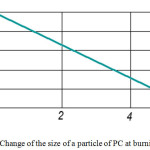 |
Figure 2: Change of the size of a particle of PC at burning out. |
The second stage of the study was an imitation of an explosion in a mine tunnel and the transverse movement of the flame front and striking elements, an explosion of pyrotechnic composition spraying water, and creating a water sultan 80 mm in thickness (fig.3). This experiment was reproduced in a large container (barrel), in which two cross-blasts were created.
The tank was filled with water of high density, by adding and dissolving in it table salt. To do this, conducted additional research, a direct shot of a mortar on a stearic target.
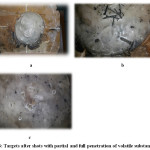 |
Figure 3: Targets after shots with partial and full penetration of volatile substances. |
As can be seen from fig.4, 5, water with dissolved sodium chloride has a higher density and, accordingly, higher protective properties.
As a result of modeling the ignition and combustion of a pyrotechnic composition with nanoaluminum, the dynamic characteristics of the ignition and combustion process were obtained and their analysis was performed.
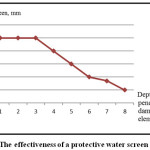 |
Figure 4: The effectiveness of a protective water screen. |
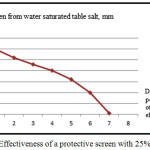 |
Figure 5: Effectiveness of a protective screen with 25% table salt. |
The dynamics of ignition and burnout of volatile gases in air with singlet oxygen increased by so much (fig. 6) that it became close to the dynamics of sublimation of volatile substances. The dynamics of the combustion of pyrotechnic gases reached its maximum, the limiting criterion of which was the dynamics of the sublimation of volatile substances.
An analysis of the ratios of the obtained rate constants of the primary reactions for both cases α1, α2, and the mass transfer coefficient (diffusion) α d showed diffusion-chemical similarity criteria Ν1 + Ν2 <1, Ν’1 + Ν’2> 1, which indicates a burning displacement into the diffusion region.
According to calculations, it has been established that all the supplied oxygen, even at the initial gas temperature of 973 K, is spent on the formation of CO and CO2. The oxygen concentration at the surface of the fuel sample is reduced to zero (from 0.178 kg O2/m3 to 0), which indicates its lack and shift of fuel combustion to the diffusion region, where the mass transfer coefficient (diffusion exchange) becomes the limiting factor.
Concentrations of CO and CO2 increase from 0.084 to 0.143 kg O2/ m3 and from 0.021 to 0.126 kg O2/ m3, respectively.
The performed calculations confirm that when using nanoaluminum in the process of burning, the intensity of the flight of volatile substances increases.
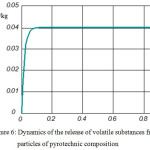 |
Figure 6: Dynamics of the release of volatile substances from particles of pyrotechnic composition. |
From the mortar charged with powder and volatile substances (canister, shot, nails, fig.6) a shot was made, the initiation was made using a hunting match, in the direction of the ball with the propane-butane gas mixture (fig.7).
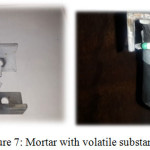 |
Figure 7: Mortar with volatile substances. |
As a result of the shot, volatile substances and red-hot particles should have blown up the ball, and the water barrier created should have prevented the spread of flame. Water ejection occurred through special holes (sprays or nozzles with a diameter of 50, 60, 70, 80 mm, fig.8), thus creating a water curtain of increased density. Mortar with striking elements imitated the explosion of a gas mixture in the mine and the further spread of the flame front in the direction of the gas ball.
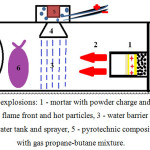 |
Figure 8: Cross explosions: 1 – mortar with powder charge and striking elements, 2 – direction of the flame front and hot particles, 3 – water barrier with a diameter of 80 mm, 4 – water tank and sprayer, 5 – pyrotechnic composition, 6 – ball with gas propane-butane mixture. |
From the mortar, a shot was made in the direction of the ball, a shot from a water cannon was made across. The thickness of the water jet (water sultan) in front of the ball varied from 20mm to 80mm. In the event that the flame of a shot pierced a water barrier, there was a rupture of the ball and the ignition of the gas mixture. If the thickness of the water was sufficient, then the ball remained intact. Thus, 14 experiments were carried out with two water formulations (tab.3).
A second shot was taken across the flame front movement from a water tank and with a pyrotechnic composition placed in a waterproof shell, which was initiated by an electric current. A water tank with a sprayer worked on the principle of a water gun, where the pressure was created by an explosion of a pyrotechnic component (fig. 9).
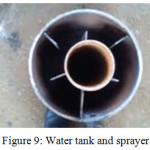 |
Figure 9: Water tank and sprayer. |
Table 3: The dependence of the penetration of a water barrier on the width of the nozzle and the density of water.
| No | The width of the nozzle of a water gun, mm | Water | Water and 25% NaCl |
| 1 | 20.0 | + | + |
| 2 | 30.0 | + | + |
| 3 | 40.0 | + | + |
| 4 | 50.0 | + | + |
| 5 | 60.0 | + | – |
| 6 | 70.0 | + | – |
| 7 | 80.0 | – | – |
Conclusion
Thus, as a result of experiments using the method of mathematical modeling, it was established that the dynamics of gas temperature rise for the case of fuel burnout with aluminum nano-additive is higher only at the initial stage of combustion. This fact is explained by an increase in the burning rate of the components of the pyrotechnic composition and an increase in the rate of formation of CO and CO2. After burning out a larger proportion of the pyrotechnic composition, the intensity of the increase in the temperature of the gases decreases, which leads to a decrease in the intensity of expansion of volatile substances. The optimal pyrotechnic composition, which punched the target to a depth of 6.5 mm, with 50 mm screen thickness, is a mixture containing ammonium nitrate components – 50%, smokeless powder – 45%, Mg – 3%, nanoaluminum – 2%. Water cannon with a nozzle with a diameter of 80 mm, allows you to localize the spread of the flame front. Therefore, the use of the method of localizing an explosion by creating a water barrier is very effective, and can be applied after conducting field testing. The most effective use of water of high density, with a 25% content of salt.
Acknowledgement
The authors wish to acknowledge the financial support of this research by the International Science and Technology Center (Project G-2209).
Conflict of Interest
There is no conflict of interest.
References
- Abdelhamid, T. S.; Everett, J. G. Journal of Construction Engineering & Management, 2000, 126(1), 52.
CrossRef - Spearing, J.S.; Greer, B.; Reilly, M. The Journal of the Southern African Institute of Mining and Metallurgy, 2011, 11, 555-563.
- Baiseitov, D.A.; Tulepov, M.I.; Sassykova, L.R.; Gabdrashova, Sh.E.; Magazova, A.N.; Dalelkhanuly, O.; Kudyarova, Zh.B.; Mansurov, Z.A. Bulgarian Chemical Communications, 2017, 49(3), 600-607.
- Lu, Kai‐Tai; Yang, Ching‐Chyuan; Propellants, Explosives, Pyrotechnics, 2008, 33(5), 403-410.
CrossRef - Podkopaev, S.; Svetlana Sаkhno, S; J of Donetsk Mining Institute, 2018, 1, 61-68. https://doi.org/10.31474/1999-981x-2018-1-61-68.
CrossRef - Sassykova, L.; Bunin, V.; Nalibayeva, A.; Nurakhmetova M. Journal of Chemical Technology & Metallurgy, 2018, 53(3), 537-542.
- Jandosov, J.; Mansurov, Z.A.; Bijsenbayev, M.A.; Tulepov, M.I.; Ismagilov, Z.R.; Shikina, N.V.; Ismagilov, I.Z.; Andrievskaya, I.P. Advanced Materials Research, 2013, 602-604, 85-89. https://doi.org/10.4028/www.scientific.net/AMR.602-604.85.
CrossRef - Sassykova, L.R. Technogenic emissions into the atmosphere: impact on the environment and neutralization by catalytic methods, Almaty: Qazaq university, 2018, 322.
- Bhaskar, K.; Sassykova, L.R.; Prabhahar, M.; Sendilvelan; S. International Journal of Mechanical and Production Engineering Research and Development, 2018, 8(1), 399-406.
- Gabdrashova, Sh.E.; Rakhova, N.M.; Pustovalov, I.O.; Elemesova, Zh.; Tulepov, M.I.; Korchagin, M.A.; Sassykova, L.R.; Sendilvelan, S.; Baiseitov, D.A. Rasayan J. Chem., 2018, 11(1), 324-330.
- Dolinar, D.R.; Bhatt, S.K. NIOSH: Proceedings: New Technology for Coal Mine Roof Support, 2000, 43–51.
- Baiseitov, D.A.; Gabdrashova, Sh.E.; Akylbai, A.K.; Dalelkhanuly, O.; Kudyarova, Zh.B.; Sassykova, L.R.; Tulepov, M.I.; Mansurov, Z.A., Int. J. Chem. Sci., 2016, 14(1), 261-268.
- Saleh, J.H.; Cummings, A.M. Safety Science, 2012, 49(6), 767-777.
- Sari, M.; Duzgun, H.S.B.; Karpuz, C.; Selcuk, A.S. Saf. Sci., 2004, 42, 675-690.
CrossRef - Haslam, R. A.; Hide, S. A.; Gibb, A. G. F.; Gyi, D. E.; Pavitt, T.; Atkinson, S.; Duff, A. R. Applied Ergonomics, 2005, 36(4), 401–415.
CrossRef - Shu-gang, C.; Yan-bao, L.; Yan-ping, W., J. Min. Technol., 2008, 18, 0172–0176.
- Coleman, P.J. Journal of Safety Research, 2007, 38, 523-533.
CrossRef - Winsdor, C. R. International Journal of Rock Mechanics and Mining Sciences, 1997, 34(6), 919-951.
CrossRef - Zheng, Y.-P.; Fenga C.-G.; Jing G.-X.; Qian, X.-M.; Li, X.-J.; Liu, Z.-Y.; Huang. P. J. Loss Prevention Process Ind., 2009, 22, 528–532.
CrossRef - Riba, S. J.; Lesaoana, M.; Sigauke, C.; Makwela, M. R. Journal of Geology and Mining Research, 2011, 3(1), 188-192.
- Sari, M.; Duzgun, H.S.B.; Karpuz, C.; Selcuk, A.S. Saf. Sci., 2004, 42, 675-690.
CrossRef - Tulepov, M. I.; Baiseitov, D.A.; Gabdrashova, Sh. E.; Sassykova, L. R.; Kazakov, Y. V. ; Tursynbek, S.; Toshtay, K.; Pustovalov, I. O.; Abdrakova, F.Y.; Mansurov, Z. A.; Dalton, A. B. Rasayan Journal of Chemistry, 2017, 10(4), 1145-1150.
- Baiseitov, D.; Tursynbek, S.; Tulepov, M.; Sassykova, L.; Nazhipkyzy, M.; Gabdrashova, Sh.; Kazakov, Y.; Pustovalov, I.; Abdrakova, F.; Mansurov, Z.; Dalton, A. Journal of Chemical Technology & Metallurgy, 2018, 53(3), 543-548.
- Baiseitov, D.A.; Tulepov, M. I.; Tursynbek, S.; Sassykova, L. R.; Nazhipkyzy, M.; Gabdrashova, Sh. E.; Kazakov, Y. V.; Pustovalov, I. O.; Abdrakova, F.Y.; Mansurov, Z. A.; Dalton, A. B. Rasayan Journal of Chemistry, 2017, 10(2), 344-348.
- Tulepov, M.; Baiseitov, D.; Sassykova, L.; Kazakov Y., Gabdrashova, Sh.; Mansurov, Z.; Dalton, A. Journal of Chemical Technology & Metallurgy, 2018, 53(2), 281-288.
- Tulepov, M. I.; Gabdrashova, Sh. E.; Rakhova, N. M.; Sassykova, L. R.; Baiseitov, D. A.; Elemesova, Zh.; Korchagin, M. A.; Sendilvelan, S.; Pustovalov, I. O.; Mansurov, Z.A. Rasayan J. Chem., 2018, 11(1), 287-293.
- Atamanov, M. K., Noboru, I.; Shotaro, T.; Amrousse, R.; Tulepov, M.; Kerimkulova, A. R.; Hobosyan, M. A.; Hori, K.; Martirosyan K. S.; Mansurov, Z. A., Combustion Science and Technology, 2016, 188(11-12), 2003-2011.
CrossRef

This work is licensed under a Creative Commons Attribution 4.0 International License.









